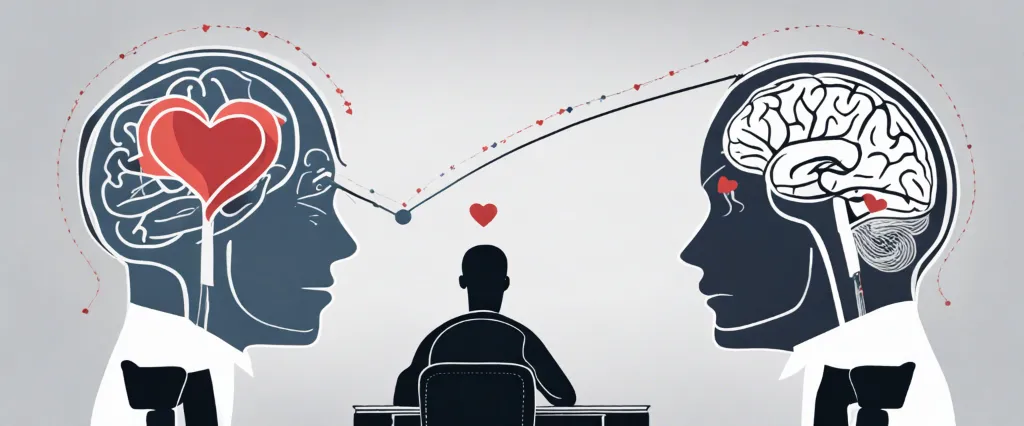In “Emotional Intelligence 2.0,” author Travis Bradberry explores the importance of emotional intelligence in personal and professional success. Drawing on extensive research and practical strategies, Bradberry offers readers tools to improve their EQ and enhance their relationships and leadership abilities. As a renowned expert in emotional intelligence, Bradberry co-founded TalentSmart, a leading provider of emotional intelligence assessments and training programs for individuals and organizations around the world. His work has been featured in leading publications such as The Wall Street Journal and Harvard Business Review.
Chapter 1: Introduction to emotional intelligence and its importance in personal and professional success.
In Chapter 1 of “Emotional Intelligence 2.0″ by Travis Bradberry, the importance of emotional intelligence in both personal and professional success is explored. The chapter begins by defining emotional intelligence as the ability to recognize and understand emotions in oneself and others, as well as the skill to manage and regulate these emotions effectively. The author emphasizes that emotional intelligence plays a crucial role in determining one’s success and overall well-being.
Bradberry discusses how emotional intelligence can impact various aspects of life, including relationships, decision-making, and career advancement. Individuals with high emotional intelligence are better equipped to navigate social interactions, handle conflicts, and make sound decisions based on empathetic understanding.
The chapter concludes by highlighting the significance of emotional intelligence in the workplace, where it is linked to better leadership, teamwork, and overall job performance. The author challenges readers to develop and strengthen their emotional intelligence through self-awareness, self-management, social awareness, and relationship management.
Overall, Chapter 1 sets the foundation for understanding the importance of emotional intelligence in achieving personal and professional success, while also providing valuable insights on how to cultivate this essential skill.
Chapter 2: Understanding the four core skills of emotional intelligence: self-awareness, self-management, social awareness, and relationship management.
In Chapter 2 of “Emotional Intelligence 2.0” by Travis Bradberry, the author introduces the four core skills of emotional intelligence: self-awareness, self-management, social awareness, and relationship management.
Self-awareness is the ability to recognize and understand your emotions, strengths, weaknesses, values, and goals. This includes being aware of how your emotions affect your behavior and interactions with others.
Self-management involves effectively managing your emotions and behaviors in different situations. This skill includes being able to control impulsive reactions, adapt to change, and remain positive in challenging situations.
Social awareness is the ability to understand and empathize with others’ emotions. This involves being able to read social cues, show sensitivity towards others’ feelings, and adjust your behavior based on the emotions of those around you.
Relationship management is the ability to build and maintain positive relationships with others. This includes effective communication, conflict resolution skills, and the ability to influence and inspire others.
Overall, these four core skills of emotional intelligence are essential for success in both personal and professional relationships, and the chapter provides practical strategies for improving and developing each skill. By mastering these skills, individuals can enhance their emotional intelligence and ultimately improve their overall well-being and success in life.
Chapter 3: Assessing your current emotional intelligence through the EQ test and identifying areas for improvement.
Chapter 3 of “Emotional Intelligence 2.0” focuses on assessing one’s current emotional intelligence (EQ) through the use of the EQ test and identifying areas for improvement. The chapter emphasizes the importance of recognizing and understanding one’s own emotions in order to better navigate social interactions and relationships.
The EQ test is a tool that measures an individual’s emotional intelligence across four key areas: self-awareness, self-management, social awareness, and relationship management. By taking the test, readers can gain insight into their strengths and weaknesses in these areas and determine where they may need to focus on improving their emotional intelligence.
The chapter also discusses common pitfalls that can hinder emotional intelligence, such as stress, negative self-talk, and not engaging with others empathetically. Readers are encouraged to reflect on their test results and identify specific areas where they can work towards growth and improvement.
Overall, Chapter 3 serves as a valuable resource for individuals looking to enhance their emotional intelligence and cultivate stronger, more fulfilling relationships both personally and professionally. Through self-reflection and targeted efforts towards improvement, readers can develop the skills needed to navigate the complexities of human emotions with greater success.
Chapter 4: Strategies for enhancing self-awareness and managing your emotions effectively.

In Chapter 4 of “Emotional Intelligence 2.0,” author Travis Bradberry outlines strategies for enhancing self-awareness and effectively managing emotions. The chapter emphasizes the importance of recognizing and understanding one’s own emotions in order to control and regulate them.
Bradberry suggests various techniques for improving self-awareness, such as keeping a journal to track emotions and triggers, seeking feedback from others, and practicing mindfulness and meditation. By becoming more aware of their emotions, individuals can better understand their strengths and weaknesses, as well as how their feelings impact their behavior and decision-making.
The chapter also delves into ways to effectively manage emotions, including techniques for reducing stress and anger, handling difficult conversations, and maintaining a positive mindset. Bradberry stresses the importance of developing emotional intelligence skills, such as empathy and self-control, to navigate challenging situations and build stronger relationships with others.
Overall, Chapter 4 of “Emotional Intelligence 2.0” offers practical advice and actionable strategies for enhancing self-awareness and effectively managing emotions in order to improve overall emotional intelligence and success in both personal and professional settings.
Chapter 5: Developing skills for understanding and empathizing with others’ emotions.
In Chapter 5 of “Emotional Intelligence 2.0” by Travis Bradberry, the focus is on developing skills for understanding and empathizing with others’ emotions. The chapter emphasizes the importance of recognizing and appropriately responding to the emotions of those around us in order to build stronger relationships and navigate social situations effectively.
The chapter starts by highlighting the benefits of emotional intelligence in building trust and rapport with others, as well as reducing conflict and improving communication. It then introduces the concept of social awareness, which involves paying attention to verbal and nonverbal cues to understand what others are feeling and why.
Bradberry provides practical strategies for improving social awareness, such as active listening, reading body language, and recognizing patterns in emotional responses. He also discusses the importance of empathy – the ability to put oneself in someone else’s shoes and understand their perspective.
Overall, Chapter 5 of “Emotional Intelligence 2.0” emphasizes the importance of developing these skills in order to enhance relationships, build stronger connections with others, and effectively navigate the complexities of social interactions. It highlights the benefits of empathy and understanding in fostering communication and building trust with others.
Chapter 6: Improving social interactions and building strong relationships through emotional intelligence.
Chapter 6 of Emotional Intelligence 2.0 by Travis Bradberry focuses on the importance of improving social interactions and building strong relationships through emotional intelligence. The chapter emphasizes the role of emotional intelligence in effectively navigating social situations and forming meaningful connections with others.
The chapter begins by highlighting the significance of emotional intelligence in relationship building and how it can enhance communication, collaboration, and conflict resolution. It discusses the importance of empathy, self-awareness, and social awareness in understanding and connecting with others on a deeper level.
The chapter also provides practical strategies for improving social interactions, such as actively listening, showing empathy, and effectively managing emotions in various social situations. It encourages readers to develop their emotional intelligence skills through self-reflection, practice, and seeking feedback from others.
Overall, Chapter 6 explores how emotional intelligence can positively impact relationships and help individuals cultivate strong connections with others. By incorporating the principles of emotional intelligence into their interactions, readers can enhance their social skills, build trust, and foster meaningful relationships in both personal and professional settings.
Chapter 7: Handling conflicts and difficult situations with emotional intelligence.
In Chapter 7 of “Emotional Intelligence 2.0” by Travis Bradberry, the focus is on the importance of handling conflicts and difficult situations with emotional intelligence. The chapter emphasizes the need for individuals to be aware of their own emotions and the emotions of others in order to effectively manage and resolve conflicts.
Bradberry discusses strategies for dealing with difficult situations, such as delaying your reaction to allow yourself time to process emotions, reframing the situation in a more positive light, and actively listening to the perspective of others involved. He also emphasizes the importance of acknowledging and validating emotions, both your own and those of others, in order to build understanding and find common ground.
Additionally, the chapter highlights the importance of taking responsibility for your actions and emotions, rather than blaming others or making excuses. By developing emotional intelligence skills, individuals can navigate conflicts more effectively, build stronger relationships, and improve their overall well-being.
Overall, Chapter 7 serves as a guide for readers to develop the necessary emotional intelligence skills to handle conflicts and difficult situations in a more constructive and productive manner.

Chapter 8: Implementing emotional intelligence techniques for continued growth and success.
In Chapter 8 of “Emotional Intelligence 2.0” by Travis Bradberry, the focus is on implementing emotional intelligence (EQ) techniques for ongoing personal and professional development. The chapter begins by emphasizing the importance of cultivating self-awareness and self-regulation to effectively manage emotions and make informed decisions. It also discusses the value of connecting with others through empathetic communication and building strong relationships based on trust and mutual understanding.
The chapter highlights the significance of social awareness in navigating social dynamics and understanding the emotions and perspectives of others. It also stresses the importance of relationship management for fostering positive interactions, resolving conflicts, and achieving common goals.
The author provides practical strategies and tips for incorporating EQ techniques in daily life, such as practicing mindfulness, actively listening to others, giving and receiving feedback constructively, and managing stress effectively. The chapter also encourages readers to set personal and professional goals that align with their values and strengths, and to continually assess and adapt their strategies for growth and success.
Overall, Chapter 8 serves as a guide for implementing emotional intelligence techniques in various aspects of life to enhance well-being, communication, and leadership skills for continued growth and success.
After Reading
Overall, “Emotional Intelligence 2.0” by Travis Bradberry provides a comprehensive guide on understanding and improving emotional intelligence. The book emphasizes the importance of EQ in personal and professional success and offers practical strategies and exercises to enhance one’s emotional intelligence. By focusing on self-awareness, self-management, social awareness, and relationship management, readers can develop their emotional intelligence skills and effectively navigate various social and emotional situations. This book serves as a valuable resource for individuals looking to enhance their interpersonal relationships, communication skills, and overall well-being.
1. Mindset: The New Psychology of Success” by Carol S. Dweck – This book explores the power of our mindset and how it can impact our success and happiness.
2. The Power of Now: A Guide to Spiritual Enlightenment” by Eckhart Tolle – Tolle’s book focuses on the importance of living in the present moment and harnessing the power of mindfulness.
3. The Gifts of Imperfection: Let Go of Who You Think You’re Supposed to Be and Embrace Who You Are” by Brené Brown – Brown’s book delves into the topic of vulnerability and authenticity, encouraging readers to embrace their imperfections.
4. Quiet: The Power of Introverts in a World That Can’t Stop Talking” by Susan Cain – This book explores the value of introversion in a society that often values extroversion, promoting self-awareness and acceptance.
5. “Daring Greatly: How the Courage to Be Vulnerable Transforms the Way We Live, Love, Parent, and Lead” by Brené Brown – Another insightful book by Brown, “Daring Greatly” explores the importance of vulnerability in cultivating meaningful connections and achieving personal growth.




